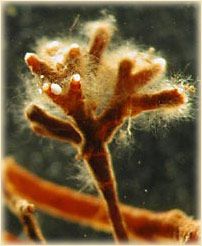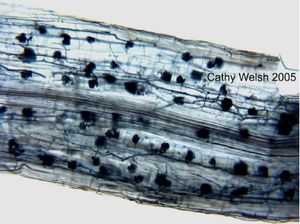
Over 2000 fungus species are known to be capable of forming ectomycorrhizaes, with most being basidiomycetes or ascomycetes. Over 80% of land plants are able to form mycorrhizal associations. In these associations there is a bidirectional flow of nutrients.
Mycorrhizae
on a root

There are two groups of mycorrhizae fungi that will be reviewed and a brief description of the feature/functionality of Plant Growth Promoting Rhizobacteria (PGPR)
The two fungi are endo and ecto. Some endo-dependent plants include vegetables, grapes, fruit trees, berries, turfgrass, and flowers. Ectomycorrhizas are found almost entirely on woody perennials including trees.
It is important to define the term rhizosphere first. Hiltner (1904) first introduced the term rhizosphere, which is derived from the Greek word 'rhiza', meaning root, and 'sphere', meaning field of influence. He defined the rhizosphere as the zone of soil immediately adjacent to legume roots that supports high levels of bacterial activity. However, more recently the term has been broadened to include both the volume of soil influenced by the root and the root tissues colonized by micro-organisms (reviewed in Pinton et al., 2001).
The rhizosphere supports diverse bacteria that can stimulate growth of plants. Such plant growth-promoting rhizobacteria operate by a wide variety of mechanisms, including N2 fixation, enhanced solubilization of P, and phytohormone production (Vessey, 2003 ; Barrea et al., 2005 )
For plants, there are two influential specific plant–microbe associations: mycorrhizaes and root nodulation. Mycorrhizaes are mutualistic symbioses between plant roots and soil fungi (Smith and Read, 1997 ). Over 80% of land plants are able to form mycorrhizal associations. In these associations there is a bidirectional flow of nutrients. Carbon flows out from the plant host to the fungus, and mineral nutrients flow from the fungus to the plant. It is estimated that between 4% and 20% of net photosynthate can be transferred from the plant to its fungal partner. In return, the mycorrhizae can become the primary organ acquiring mineral nutrients
The establishment of the mycorrhizal network offers a number of basic advantages for the acquisition of mineral nutrients: fungal hyphae extend beyond the area of nutrient depletion surrounding the root; fungal hyphae greatly increase the surface area for the absorption of nutrients relative to non-mycorrhizal roots; hyphae are able to extend into soil pores that are too small for roots to enter; and some mycorrhizal fungi can access forms of N and P that are unavailable to non-mycorrhizal plants, particularly organic forms of these nutrients
Many farming practices, including fertilizer application, cultivation, and fumigation can have deleterious impacts on communities of AM fungi (Kurle and Pfleger, 1994 ), which are known to be less diverse and abundant in conventional agricultural systems relative to organically managed and semi-natural areas
Arbuscular mycorrhizas (AM, also called endo) are the commonest mycorrhizal group, and are found on angiosperms, gymnosperms, pteridophytes, and bryophytes. The association is very close and the fungal hyphae penetrate root cortical cells to form arbuscules to exchange nutrients and carbon. About 150–200 obligate biotrophic AM fungi have been described so far, which all belong to the Glomeromycota (Schussler et al., 2001 ).
Over 2000 fungus species are known to be capable of forming ectomycorrhizaes, with most being basidiomycetes or ascomycetes. Hyphae penetrate into the root cortex where they ramify between cells to form a 'Hartig net', through which materials are exchanged. The fungus forms a mantle of hyphae on the outside of the plant root which extends into the surrounding soil. The primary function of the fungal mycelium is absorption of nutrients from the soil, and the translocation of these materials to the host. Ectomycorrhizal fungi have been shown to translocate mineral forms of N, P, and micronutrients from the soil to the host.
Many rhizosphere fungi, including mycorrhizal fungi, are able to suppress soil-borne plant pathogens (Whipps, 2001 ). Fungi have the advantage over bacterial biocontrol agents in that they are generally more effective at spreading through the soil and rhizosphere. A variety of mechanisms are involved in the control of fungal pathogens by rhizosphere fungi, including competition for nutrients, antibiotic production, and induced resistance. In addition, many fungi are able to parasitize spores, sclerotia, or hyphae of other fungi, resulting in biocontrol.
Overall, it is the loss of carbon compounds from roots that drives the development of enhanced microbial populations in the rhizosphere when compared with the bulk soil (Grayston et al., 1996 ). This phenomenon is widespread across all plant species as a general process, although the compounds lost from different plant species, or even cultivars of particular species, can vary markedly in quality and quantity. Conversely, the micro-organisms in the rhizosphere can influence plants in a variety of ways, for example affecting plant growth, nutrition, development, susceptibility to disease, resistance to heavy metals.
Other benefits are increased nutrient and water aborption, nutrient mobilization, increase in feeder root longevity, accumulation of nitrogen, phosphorous, potassium, calcium, zinc and their translocation to the host tissue, minerals get mobilized in F and H horizons before they reach the sub soil system. Provide the host plant with growth hormones like auxins, cytokinins, gibberellins and growth regulators such as Vitamin B, plays a significant role in nutrient cycling and the entry of the fungai biomass into soil organic matter pool.

